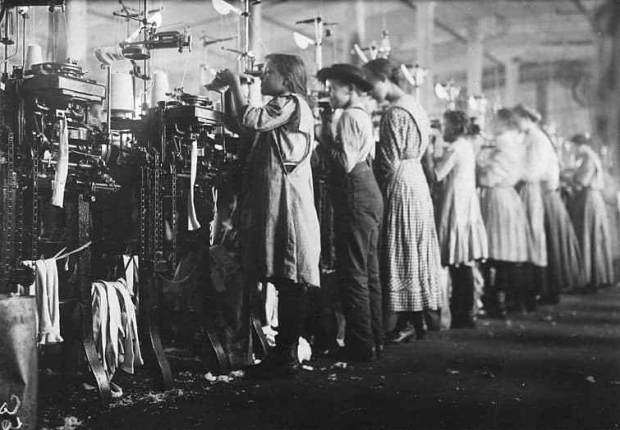The green silk faille, chenille circa two-piece day dress made in 1865, France or England can be considered a key discussion when it comes to historical sustainability in textiles. The dress was designed for the upper class and it is now held in The Bata Shoe Museum in Toronto (Fig.1)
Arsenic green dye decorated the attire of Victorian Britain (Bartrip, 1994) and was a by-product of the mining industry that was itself innocuous but when combined with other elements became lethally toxic (Anderson, 2011). Favoured for its radiant colour, durability and inexpensive production, the use of emerald green dye continued undeterred with no concern of the harm it was causing to the people and environment at the time. The pigment, known as Emerald or Scheele’s green was created in 1814 in Schweinfurt, Germany at the Wilhelm Dye and White Lead Company and was constructed with copper sulphate, oxide of arsenic, potash and acetic acid (Pigment Through the Ages, 1999).

Fig.3. The illustration ‘The Arsenic Waltz’ as seen in Punch (1862) depicts the fatal danger of arsenic in clothing and artificial flowers.
By 1870, the sickening of dye-workers and the occurrence of fatalities was connected to the lethal use of arsenic dyes (Holloway and Chase, 2010). The process of dyeing such textiles has historically been one of the most discernible forms of pollution (Lawrence Keane, 2010). This statement is supported by evidence from Gorden and Hill (2015) who claim workers suffered from skin irritation, to harmful effects to the eyes and respiratory system through inhalation of the toxin or contact with the skin.

Fig.4. London and Paris Magazine (1840) Arsenical Green Fashion Plate.
As well as the toxicity of the dye used in the green dress, another concerning issue of production was the process of manufacturing the garment. As stated by Meier (2014) industrialisation and mass production reshaped Victorian fashion and with this also came the risk of fatalities.
As mentioned the green dress was constructed with silk faille, a material produced from the chrysalis of silkworms (Fletcher, 2008). The silk worms would have been cultivated and the silk filament would have been extracted by steaming to kill the silk moth which challenges the ethicality of production. Additionally, child labour was used in the 19th century with children expected to work in poor and hazardous conditions (Tozer and Levitt, 1983) using primitive technology. As a result, workers were forced to use labour intensive and time consuming hand-operated looms, thus adding to the risk associated with the emerald green dress.

Fig.5.The Ten Hours Act of 1847 – Child Labor in England During the Industrial Revolution.
Word count: 386
References
Anderson, S. (2011) James C. Whorton, The Arsenic Century: How Victorian Britain was Poisoned at Home, Work and Play. Social History of Medicine, Volume 24, (Issue 1), pp.196-197.
Baird, A. (2002) Silk in England. [Online]. Available at: https://www.smith.edu/hsc/silk/papers/baird.html [Accessed 25 March 2018].
Bartrip, P.W.J. (1994) How Green Was My Valance?: Environmental Arsenic Poisoning and the Victorian Domestic Ideal. The English Historical Review, Vol. 109, (Issue. 433), p.895.
Emsley, J. (2005) The Elements of Murder: A History of Poison. Oxford: Oxford University Press.
Farley Gorden, J. and Hill, C. (2015) Sustainable Fashion Past, Present and Future. London: Bloomsbury Publishing.
Fletcher, K. (2008) Sustainable Fashion & Textiles: Design Journeys. London, Earthscan.
Holloway, S. and Chase, L. (2010) A Deadly Shade of Green. [Online]. Available at: http://twonerdyhistorygirls.blogspot.co.uk/2010/06/deadly-shade-of-green.html [Accessed 15 March 2018].
Lawrence Keane, L (2010) Eco-Fashion: Going Green. [Press Release] The Museum at FIT Available at: http://www.fitnyc.edu/news-archive/2010/may-1.php [Accessed 15 March 2018].
Meier, A. (2014) Fatal Victorian Fashion and the Allure of the Poison Garment [Online]. Available at: https://hyperallergic.com/133571/fatal-victorian-fashion-and-the-allure-of-the-poison-garment/ [Accessed 25 march 2018].
Pigment Through the Ages (1999) Emerald Green. [Online]. Available at: http://www.webexhibits.org/pigments/indiv/recipe/emerald.html [Accessed 15 March 2018].
Tozer, J. and Levitt, S. (1983) Fabric of Society a Century of People and Their Clothes 1770-1870. Wales: Laura Ashley Publication.
Images
FIG.1
Bata Shoe Museum, (2015) Emerald Green Dress – English or French, c. 1860-1865 [Online Image] Available at: http://www.batashoemuseum.ca/fashion-victims/ [Accessed 25 March 2018].
FIG.2
The Museum at Fashion Institute Technology (2010) Two-piece day dress – Green silk faille, chenille – Circa 1865. [Online Image] Available at: http://sites.fitnyc.edu/depts/museum/Eco_Fashion_Going_Green/iFrames/iFr_gall_16.html [Accessed 15 March 2018].
FIG.3
London and Paris Magazine (1840) Arsenical Green Fashion Plate [Magazine Print] In: Matthews David, A. (2015) Fashion Victims: The Dangers of Dress Past and Present. Bloomsbury Visual Arts, London
FIG.4.
Matthews David, A. (2015) The Arsenic Dress: How Poisonous Green Pigments Terrorized Victorian Fashion. [Online Image] Available at: https://pictorial.jezebel.com/the-arsenic-dress-how-poisonous-green-pigments-terrori-1738374597 [Accessed 14 March 2018].
FIG.5
Bellamy Foster, J and Clark, B (2018) The Ten Hours Act of 1847 – Child Labor in England During the Industrial Revolution. [Online image]. Available at: https://monthlyreview.org/2018/01/01/women-nature-and-capital-in-the-industrial-revolution/#lightbox/0/ [Accessed 30 March 2018].

